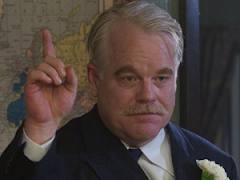
A film and its soundtrack, they go together; or do they? It’s not always obvious and I’m talking about the continuity dialogue-and-music version, not the music-only separately issued one. It’s all about context, stating the obvious, choice; and above all the interpretative ability of the composer and the allied decisions to use song-based or instrumental material that already exists that can amplify the story. In Paul Thomas Anderson’s The Master the director is reunited with film composer Radiohead’s Jonny Greenwood, following their previous work together on There Will Be Blood.
The music that Greenwood didn’t compose reflects the film’s period setting to an extent, and it has a jazz-tinged and popular music quality to it, relating to the 1940s following victory in Japan, the beginning of a new era as traumatised navy veteran Freddie Quell (Joaquin Phoenix) becomes part of The Cause, the cultish Scientology-like group led by charismatic Lancaster Dodd (Philip Seymour Hoffman, above). Greenwood’s music harnesses electronic textures via acoustic means and dense harmonic strings-laden clusters that particularly in the second half of the film, past the one-hour mark, uses clarinet a great deal. Some of the instrumentalists on the score, released by Nonesuch records on 5 November, are jazz people including former Humphrey Lyttelton sideman the veteran mainstream musician Jimmy Hastings, and a voice of the new generation, Sons of Kemet clarinettist Shabaka Hutchings, along with Zed-U bandmates Neil Charles and Tom Skinner.
The key non-Greenwood music comes in three main varieties each with particular justifications in terms of plot and context.
The first is the inclusion of the Ella Fitzgerald version of the Irving Berlin song ‘Get Thee Behind Me Satan’, chosen I suppose for its playful hint of menace and played against a show of photographs.
The second is ‘No Other Love’ (the spooky song that owes much to Chopin’s ‘Tristesse’) sung by Jo Stafford, which belongs to the Arizona section of the film where the Master finds himself, in Phoenix, addressing the first congress of The Cause. While impactful it retains a non-literal ambivalence in terms of narrative.
And finally the third song is Helen Forrest’s version of ‘Changing Partners’ in waltz time accompanied by the Sy Oliver orchestra (think the feel of ‘Tennessee Waltz’ a tune that Sonny Rollins interpreted in its definitive jazz treatment). This last song charts the ultimate choice of Freddie after his final dealing with Dodd in his mansion in England where the action moves to after some wanderings in America and quite some time after the seafaring episodes in the early part of the film.
The Greenwood soundtrack itself in the context of the film, leaving aside the songs referred to, and they are important, has a great deal of depth and an abstract logic to it unlike much modern cinema composition that relies on mood-setting minimalism as a jumping off point, or anthemic electronica even no matter the period. Texturally Greenwood’s approach adds gravitas and provides parallel, although properly allusive, commentary on the drama. It also never distracts and integrates itself organically. The Master is absorbing, stimulating, a quite brilliant piece of film-making and thought-provoking storytelling, beautifully acted and shot. It’s a film that people will, hazarding a wild guess, be talking about for a long time to come. Stephen Graham
In cinemas from Friday